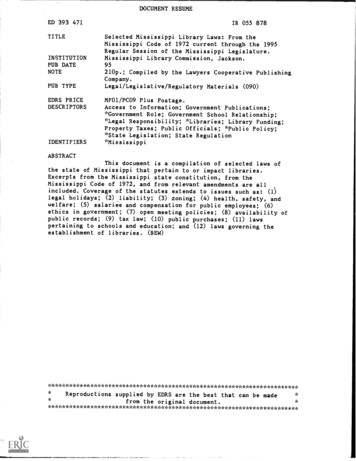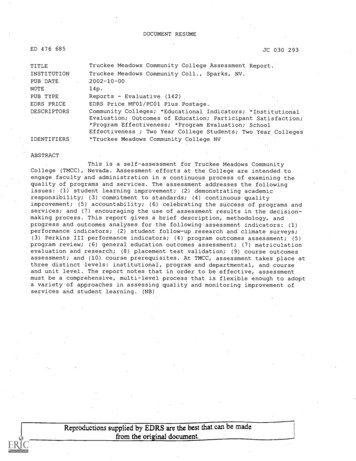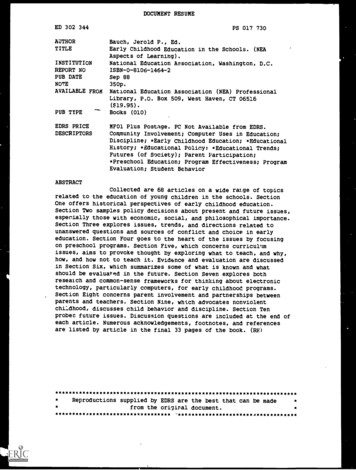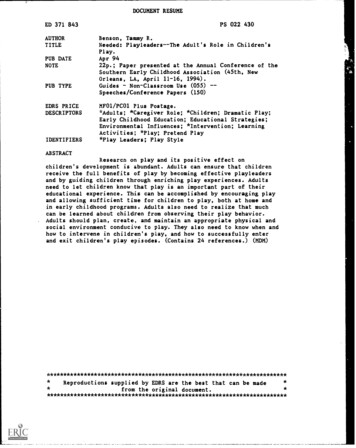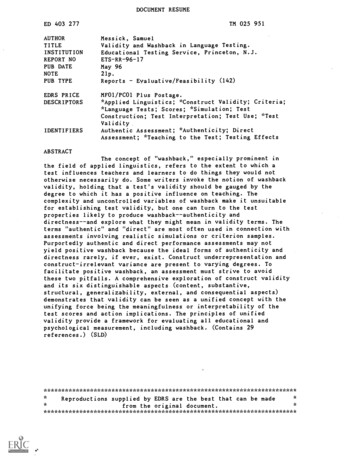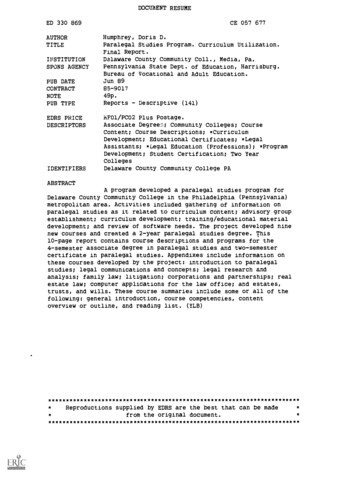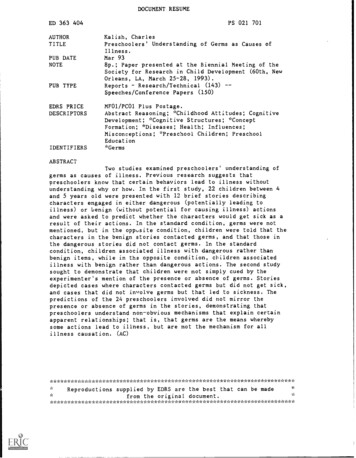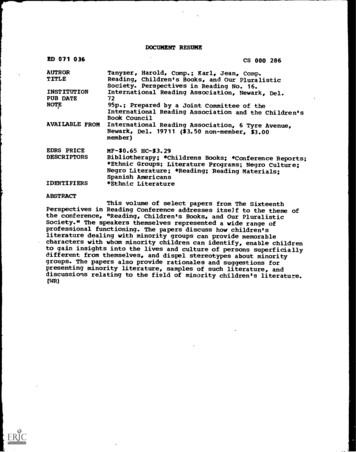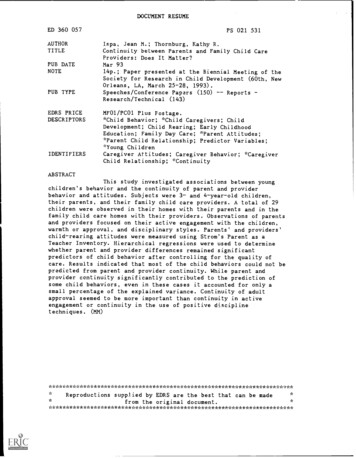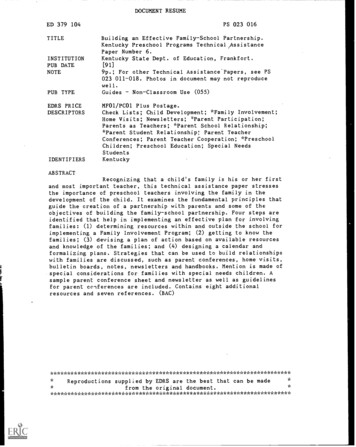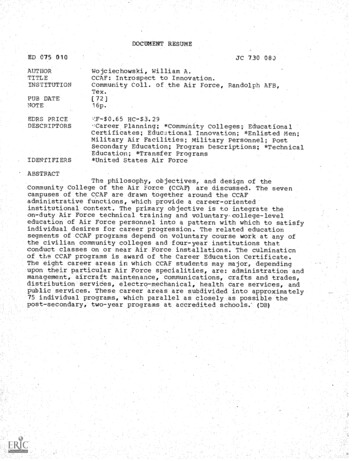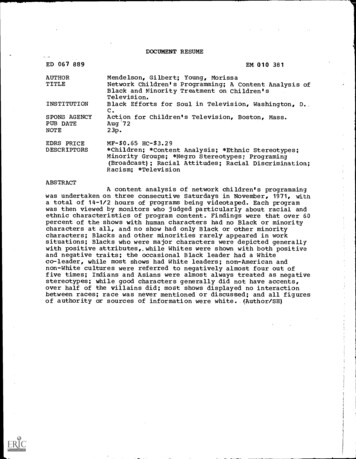
Transcription
DOCUMENT RESUMEED 067 889AUTHORTITLEINSTITUTIONEM 010 381Mendelson, Gilbert; Young, MorissaNetwork Children's Programming; A Content Analysis ofBlack and Minority Treatment on Children'sTelevision.Black Efforts for Soul in Television, Washington, D.C.SPONS AGENCYPUB DATENOTEAction for Children's Television, Boston, Mass.Aug 72EDRS PRICEDESCRIPTORSMF- 0.65 HC- 3.29*Children; *Content Analysis; *Ethnic Stereotypes;Minority Groups; *Negro Stereotypes; Programing(Broadcast); Racial Attitudes; Racial Discrimination;Racism; *Television23p.ABSTRACTA content analysis of network children's programmingwas undertaken on three consecutive Saturdays in November, 1971, witha total of 14-1/2 hours of programs being videotaped. Each programwas then viewed by monitors who judged particularly about racial andethnic characteristics of program content. Findings were that over 60percent of the shows with human characters had no Black or minoritycharacters at all, and no show had only Black or other minoritycharacters; Blacks and other minorities rarely appeared in worksituations; Blacks who were major characters were depicted generallywith positive attributes,, while Whites were shown with both positiveand negative traits; the occasional Black leader had a Whiteco-leader, while most shows had White leaders; non-American andnon-White cultures were referred to negatively almost four out offive times; Indians and Asians were almost always treated as negativestereotypes; while good characters generally did not have accents,over half of the villains did; most shows displayed no interactionbetween races; race was never mentioned or discussed; and all figuresof authority or sources of information were white. (Author/SH)
FILMED FROM BEST AVAILABLE COPYU.S. DEPARTMENT OF HEALTH,EDUCATION & WELFAREOFFICE OF EDUCATIONTHIS DOCUMENT HAS BEEN REPRODUCED EXACTLY AS RECEIVED FROMTHE PERSON OR ORGANIZATION ORIGINATING IT. POINTS OF VIEW OR OPIN-IONS STATED DO NOT NECESSARILYREPRESENT OFFICIAL OFFICE OF EDUCATION POSITION OR POLICY.NETWORK CHILDREN'S PROGRAMMINGA Content Analysis of Black and Minority Treatment OnChildren's TelevisionAugust 1972Prepared ForAction for Children's TelevisionbyGilbert MendelsonMorrissa Young"PERMISSION TO REPRODUCE THIS COPYRIGHTED MATERIAL HAS BEEN GRANTEDBY0Black Efforts for Soul in Television1015 N. Carolina Avenue, S.E.Washington, D.C.20003f1 N 4-1.1.0r1Chldrer;S-Foy.e;MISSION OF THE COPYRIGHT OWNER."01;onTO ERIC AND ORGANIZATIONS OPERATINGUNDER AGREEMENTS WITH THE U.S. OFFICEOF EDUCATION. FURTHER REPRODUCTIONOUTSIDE THE ERIC SYSTEM REQUIRES PER-BESTAction for,Children's Television
AcknowlegementsWe wish to thank Ms. Mignon Anderson and Ms. Cynthia Matthewsfor their help in the monitoring which formed the basis forthis report.
CONTENTSPAGEIntroduction1Summary of Findings2Methodology3Number of Characters by Race4Occupations, Aims and Roles ofCharacters5Cultures and Ethnic Groups6Relationships between Black andWhite Characters7Content Analysis and Further Study8Appendices:I.II.Programs &nitoredInstructions for MonitorsTablel:Number of Characters by RaceTable II: Roles of CharactersTable III: Aims and Values. Projectedby Major CharactersTable IV:Table V:Occupational Status ofMajor CharactersReferences to Other Cultures;Language of Characters
IntroductionAs previous studies have documented, American society is becoming increasingly dependent upon visual modes of communication.The average child now growing up in our society will, by the timehe is 65, have spent approximately nine years of his life beforea television screen.The impact of this statistic is particularly significant forBlack and low-income children.Researchers have documented thatchildren in these two groups spend even more time watching television, and perceiving its content as reality.The ViolenceCommission, in'its report, stated, "Television is a particularlypotent force in families where parental influence and family groupties are weak or completely lacking, notably in low-income areas.In these instances, television does not displace parental influence,it fills a vacuum."The BEST study of children's programming was undertaken pri-marily as a content analysis of Black and minority treatment onthese programs.The analysis was carried out through the monitoringof 1411 hours of network programming, designated by the networks aschildren's fare.Although a complete analysis both of program con-tent and methodology is included in a separate section of this report,the following is a brief summary of the major findings.
A Brief Summary of Major Findings1.Black and other minority characters make up a small percentage of characters, 7% and 2% respectively;2.Over 60% of the shows with human characters have no Blackor minority characters at all; no show has only Black orother minority characters;3.Blacks and other minorities rarely appear in work situations,while whites often appear as managers, professionals, lawofficers, workers and bums;4.Blacks who are major characters are depicted generally withpositive attributes, while whites are shown with bothpositive and negative traits;5.There are several Black heroes, but no Black villains;6.The occasional Black leader has a white co-leader, whilemost shows have white leaders;7.Non-American and non-white cultures are referred to negativelyalmost four out of five times;8.Indians and Asians are almost always treated as negativestereotypes;9.Only occasionally does a good character speak with an accent,or in dialect, while over half the villains speak with accents,most commonly German or Russian;10.Most shows have no interaction between races, and in most caseswhere there are integrated groups, there is one Black among thegroup;11.In the two shows with Black stars, Blacks interact only withwhite characters;12.Race is never mentioned or discussed;13.All figures of authority, or sources of information, e.g., onshows designated as educational, are white.-2-
MethodologyBEST's content analysis of network children's programmingwas based on a sample of children's programs broadcast three consecutive Saturdays in November, 1971. (CBS, November 13, 1971;ABC, November 20, 1971; NBC, November 27, 1971)hours of programs were videotaped.A total of 1415These are the same programswhich formed the basis of F. Earle Barcus' "Netvork Programming andAdvertising in the Saturday Children's Hours: A June and NovemberComparison", researched for Action for Children'sTelevision.During 'August 1972,the tapes were viewed by a team ofspecially trained monitors.Each program was viewed by two moni-tors.who scored the results on a specially prepared questionnaire.Each monitor was instructed to look for specific actions, andjudge from theprograms content data about race and ethnic characteristics.Directly following viewing, the monitors compared andreconciled their tabulations.Any discrepancies were reconciled byviewing the tape a second time.Only the program material was classified; the commercials andother non-program material was ignored.A separate monitoring formwas completed for each program segment.A segment was defined asa unit composed of homogeneous program content - a story, cartoon,musical segment.Consequently, some programs could have more thanone program segment. (See Appendix II for instructions to monitors)
Number of Characters by RaceThe monitoring results for the Saturday morning networkprogramming on ABC, CBS, and NBC reveal that of the 47 programsegments broadcast during the approximately 141/2 hours of pro-gramming, a total of 440 identifiable characters appeared.(Thisexcludes crowd shots where no identification or tabulation waspossible).Sixty-one percent of the characters were white, 30percent were classified "not applicable".This category includesanimals, monsters and imaginary characters.Blacks accounted for7 percent of the characters; other non-white minorities accountfor 2 percent.A program by program examination indicates that 40 of the 47segments had white characters, 26 had animal or other non-humancharacters, and only 11 had Black characters.Six had otherminorities :When whites appeared, there were, on the average, 6 per segment.When Blacks appeared, on the average there were only 2.No segment had more than 2 other minorities.Non-humans averagedmore per segment - 3 - than did minorities.Twenty-five shows hadall white human characters.No show had all Black or other minoritypeople.Looking at the number of major characters in the segmentsindicates that 69 percent were white, 18 percent non-human, 11 percent Black and 2 percent other minorities.(The roles and treatmentof the characters will be discussed later in the report).Thirty-four segments had white major characters, 16 had non-humans, 8 hadBlack, and 3 had other minorities.-4-Twenty-five segments had all white7
leads; only one had a Black lead only ( a convict making good asa boxer), and one had another minority lead (an Indian boy beingbeaten by Woody Woodpecker).Occupations, Aims and Roles of the CharactersExamining the characters when they appeared in job situations, 13 whites, 2 non-humans and no Blacks were portrayed asmanagers or administrators.Thirty-three whites, 4 non-humansand 5 Blacks (basketball players) appeared as professionals.There were 18 white skilled workers, one non-human and no Blacks.Seven whites,2 Orientals (Charlie Chan and son), and no Blackswere law enforcement officers.as unskilled workers.One Black and 4 whites appearedOne Black, one other. minority and 12 whitesappeared as bums or criminals.The data reveals that Blacks rarelyappear in work situations.The characters were analyzed for specific behaviors thatcould be classified as indicating goals and values.The attributesfor white characters were "concern for others" (29 characters);"materialistic" (18)"creative" (17); "destructive" (17)or incompetent" (14)"selfish" (13);"pursuing power or success" (12) ;"hardworking" (11); "Self-rerTect" (11), and "lazy" (7)."stupidFor Blacks,the order of attributes was "concern for others" (10); "creative" and"hardworking" (6); "stupid and incompetent" (3);. "lazy and materialistic"(1).It is interesting to note that the three most common attributes.for Blacks are positive traits, while white characters haveamixture ofpositive and negative traits.
This difference is due in part to the fact that white charactersplay good guys and villains as well as minor parts; Blacks onlyplay good guys or minor parts.Three programs have Black heroes:the'blobetrotters'i theFive programs have white heroes.Jackson Fivellatld the Bugaloos.There are 10 shows with white villains, but no Blacks play theheavies on Saturday morning.There are 21 white characters inleadership roles, and only two Blacks.Both Black leaders havehelp in their leadership position by white co-leaders.Other Cultures and Ethnic GroupsThe overwhelming bulk of shows are set in the United States,or in a non-descript, non-ethnic and totally amalgamated environHowever, about half the segments make reference to or depictment.another country, culture or group of people.Only two shows make reference to other cultures with respectand admiration.Two segments of"The Curiosity ShopUpraise thearchitectural achievements of Egypt, China, Greece, Rome and Europe;one show also praises French cooking.However, when a villain orunpleasant climate is needed, 10 European, 4 Asian and 4 Indiancultures or people are stereotyped.Two shows depict gypsies astricky and dirty; swiss yodelers are called "nuts"; a French person is depicted as power hungry.Three Italians appear as gangstertypes, along with a Russian dictator and a German rat.All four showswith minorities as major characters depict them as derogatory stereotypes.A Chinese coolie and a stupid Hawaiian appear in Road Runner ;'-6-
Jerry Lewis has a Charlie Chan character, andhas a Chinese villain.and the Pussycats"All four references to American Indians arederogatory.The characterization of persons us.i.ng dialect is interesting.Although nearly all characters speak standard English, 22 segmentshave some characters speaking in dialect.In only two cases do0heroes use dialect (The Jackson Five speak largely in slang, andthe'Bugaloos': including the Black group member, speak a kind ofcockney English).Nine of 16 villains have an accent: 4 German,2 Russian, 1 hillbilly, and 1 Frenchman.All Oriental characterswho have dialogue speak"pidgin" English.Relationships Between Black and White CharactersOnly 6 of the 47 segments monitored had significant or substantive relationships between Black and white Characters.In three of the 6 segments, one Black person was a full andequal part of the group.In the''Bugaloos',/ the Black person wasone of four flying, bug-like people who spoke a cockney English.In Take a Giant Step"(NBC), one of the three children who served ashost was Black; in Josie and the Pussycats': one of the singers wasBlack.Two of the programs were animated comedies based on the charactersof all Black groups, hedJackson Five" (ABC) and thellarlem Globetrotters"(CBS).In each of these half hour shows, the Black groupswere the major characters.In the Globetrottersli the team managerwas "granny", an elderly white woman who the Globetrotters greatlyrespected.(The "plot" of this segment was the Globetrotters tryingto get granny a birthday present.)Granny's relationship to the10
Globetrotters was one of mild condescension.For example, shakept their money for them because she was afraid they would lose it.However, there was mutually expressed affection between them.Inthe jackson Five "story, which was the "Wizard of Oz" in Blackface,Michael and the other members of the group appeared in awe of, andshowed great respect and deference to the white witch.It isinteresting to note that these Black characters appear in an essentiallyall-white society.The Jackson Five "meet only whites, and the"Harlem Globetrotters see only two other minor characters who are lostin th
No segment had more than 2 other minorities. Non-humans averaged more per segment - 3 - than did minorities. Twenty-five shows had all white human characters. No show had
